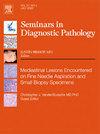头颈部黄色肉芽肿性上皮肿瘤/富含角蛋白阳性巨细胞肿瘤
IF 3.5
3区 医学
Q2 MEDICAL LABORATORY TECHNOLOGY
引用次数: 0
摘要
黄色肉芽肿上皮肿瘤(XGET)和富含角蛋白阳性巨细胞肿瘤(KPGCT)代表了单一肿瘤实体谱的两端,具有重叠的临床、形态学、免疫组织化学和遗传学发现(XGET/KPGCT)。形态学上,它们的特征是黄瘤组织细胞、图顿样巨细胞、破骨细胞样巨细胞和散布的角蛋白阳性细胞的高度可变混合物,在常规染色玻片上可以看到嗜酸性上皮样细胞簇,或者需要免疫组织化学检测。XGET和KPGCT都含有HMGA2的重排,最常见的是NCOR2,这支持了它们的单一性。它们最常见于年轻成年女性,可累及软组织或骨骼部位,表现为交界性恶性间充质肿瘤,有局部复发的风险,但转移风险很小。在英语文献中报道了大约61例,其中头颈部有13例。这篇综述将总结这些肿瘤在解剖部位的已知信息,并强调头颈部独特的诊断挑战。本文章由计算机程序翻译,如有差异,请以英文原文为准。
Head and neck xanthogranulomatous epithelial tumors/keratin-positive giant cell-rich tumors
Xanthogranulomatous epithelial tumor (XGET) and keratin-positive giant cell–rich tumor (KPGCT) represent ends along the spectrum of a single neoplastic entity, with overlapping clinical, morphologic, immunohistochemical, and genetic findings (XGET/KPGCT). Morphologically, they are characterized by a highly variable admixture of xanthomatous histiocytes, Touton-like giant cells, osteoclast-like giant cells, and interspersed keratin-positive cells, which may be visible on routinely stained slides as clusters of eosinophilic epithelioid cells or require immunohistochemistry for detection. Both XGET and KPGCT harbor rearrangements of HMGA2, most often with NCOR2, supporting their unitary nature. They most often occur in young adult females, may involve either soft tissue or osseous locations, and behave as mesenchymal tumors of borderline malignancy, with risk for local recurrence but little metastatic risk. Approximately 61 cases have been reported in the English literature, including 13 cases in the head and neck region. This review will summarize the known information on these neoplasms across anatomic sites and highlight diagnostic challenges unique to the head and neck region.
求助全文
通过发布文献求助,成功后即可免费获取论文全文。
去求助
来源期刊
CiteScore
4.80
自引率
0.00%
发文量
69
审稿时长
71 days
期刊介绍:
Each issue of Seminars in Diagnostic Pathology offers current, authoritative reviews of topics in diagnostic anatomic pathology. The Seminars is of interest to pathologists, clinical investigators and physicians in practice.

 求助内容:
求助内容: 应助结果提醒方式:
应助结果提醒方式:


